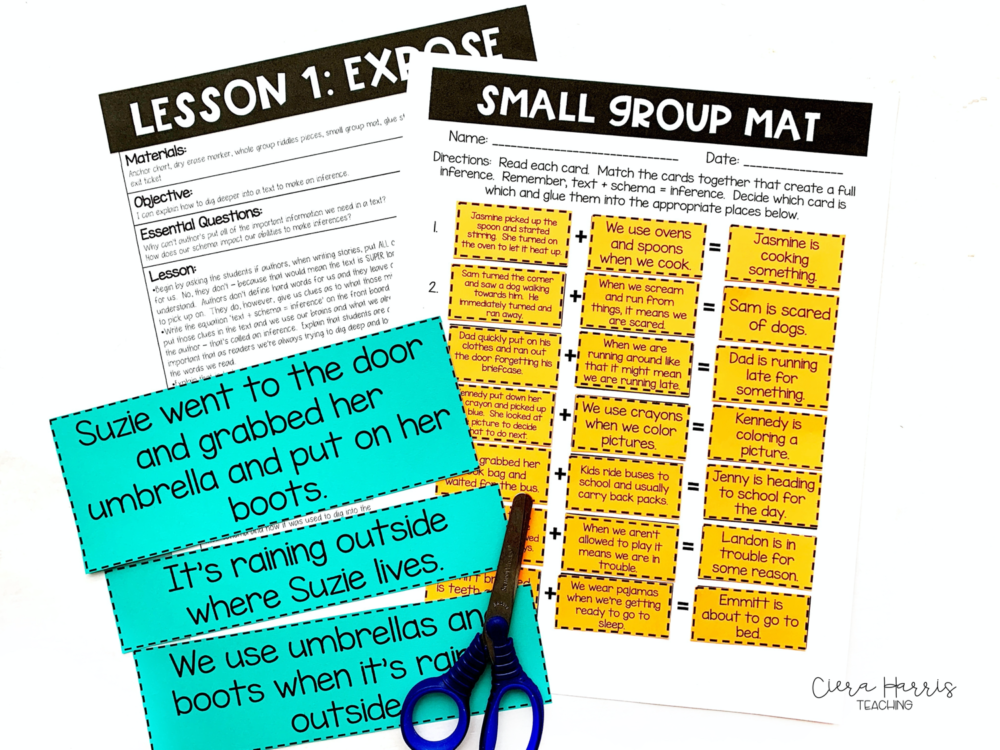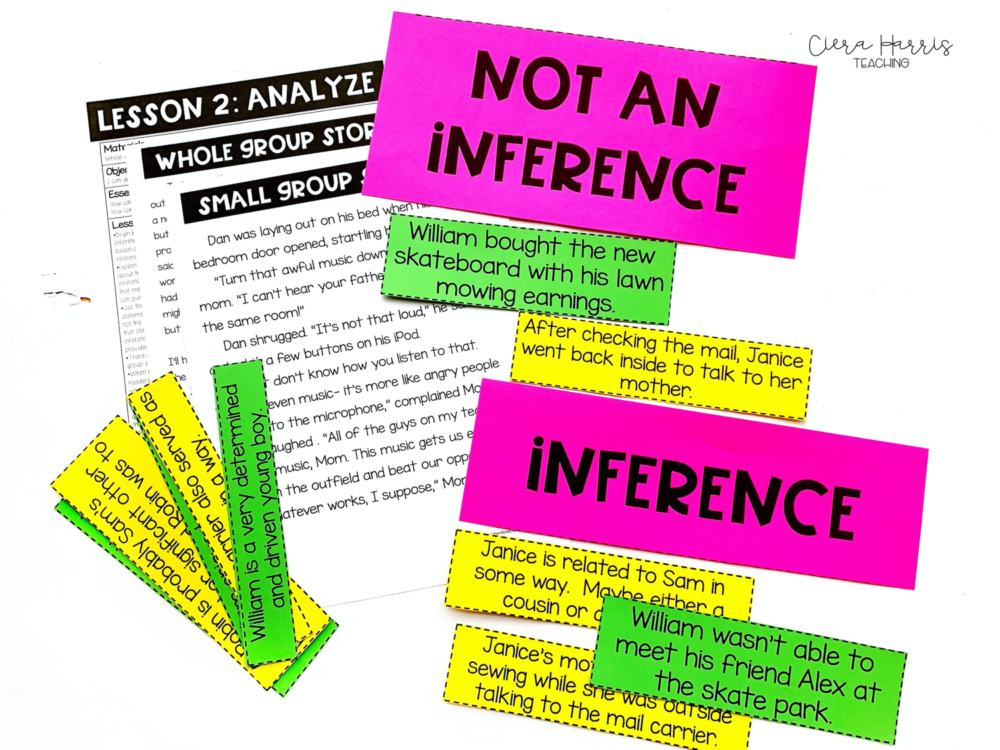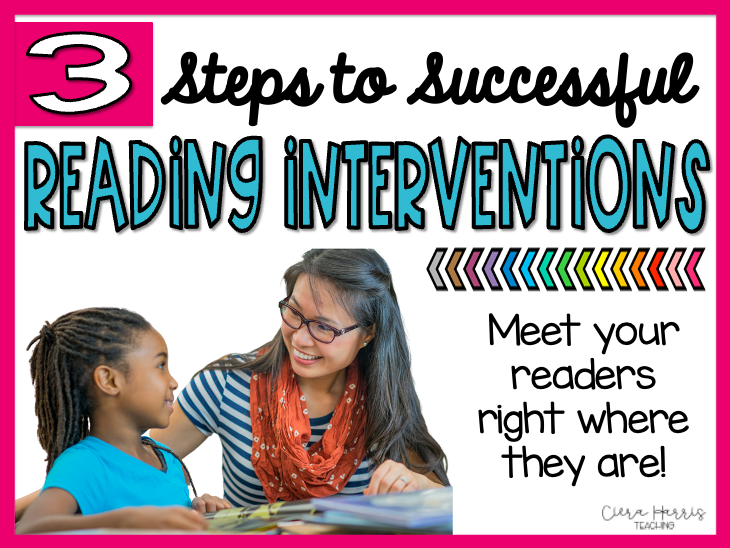Students need to understand how to use many different skills and strategies in order to become a proficient reader. From understanding the different story elements to identifying the text structure, juggling everything can get tricky. It’s important when teaching reading skills to focus on one skill at a time for an extended period of time to allow students to completely build up their understanding and application of the skill. This is no different for the skill of making inferences! I’ve gathered my best making inference tips to share with you!

Making an inference is simply an extension of the understanding that goes beyond the text. It’s information what the author didn’t tell the reader. I know teaching making inferences is one of the trickiest skills of all. It takes a while for students to understand when and where they are making inferences when they read. It also is hard for students to make deep inferences when they lack schema and the ability to identify proper text evidence. When it comes to making inferences, here’s what I have found that helps! (You can also check out these tips about cause and effect, summarizing, and text structure!)
Making Inferences Tips & Tricks:
- When practicing making inferences, use photographs! Using photographs and allowing students to infer what is happening, why it’s happening, etc helps students to practice making inferences without the added pressure of reading. They use text evidence (details from the photo) and their schema to explain their inferences. You can use daily photo-talks as a great warm-up in reading class to have continued practice on this important skill.
- When practicing making inferences, try to combine it with as many other skills as possible. This shows students that even other skills we use when reading includes making inferences. For example, identifying the setting many times is actually inferred. When identifying the traits of a character, these are inferred. Making predictions, we infer based on what’s happening in the story and what we know about these situations. Because students can relate making inferences to other skills they know, they become more aware of the skill happening and more confident as well.
- One bit tip when teaching making inferences is to have students determine the differences between literal and inferential information. They can do this by reading a short text and then are given short sentences related to the text. Some of the sentences are literal information, taken right from the text. Students can SEE with their own eyes this piece of information in the story. The other sentences are inferential information. Students won’t be able to SEE the information in the story, therefore it must be inferred. Doing a fun sort like this shows students that there is information beyond the actual story.
- With almost any skill, making inferences is heavily based on using schema. Schema is the prior knowledge a student brings to a text. Students NEED to understand that without accessing this schema, and actively thinking about it, making inferences in a text is impossible. We can help students make inferences by continuously activating their schema for them prior to reading, and throughout reading a story.
- Students won’t be able to pick up on the natural process of making inferences if they don’t see and hear it constantly. This means our ability to model this skill out loud for students is imperative. Any time we are reading aloud to students, we need to be very aware of the inferences we are making and model those for our students. The more they see and hear them the more they will become a habit.
So what does a week’s worth of making inference lessons look like in my classroom? And how do I include all of these tips into my lessons? Here’s how!
Making Inference Lesson #1:
 On Monday, I focus on all of the pieces of an inference – the text, the schema, and the inference itself. I want students to know each piece, it’s importance, and the differences between them. How do I do this? I have students read an inference and all of its pieces and sort them!
On Monday, I focus on all of the pieces of an inference – the text, the schema, and the inference itself. I want students to know each piece, it’s importance, and the differences between them. How do I do this? I have students read an inference and all of its pieces and sort them!
So when students read the inference they are sorting the pieces based on which came from the schema, which came from the text, and which is the actual inference. This helps students to see the formula of making an inference and understand that all pieces are important.
Making Inference Lesson #2:
On Tuesday, we focus on literal vs. inferential information. I want students to be able to see that some information comes from the  actual text and some comes from beyond the text. You can do this by having students read a simple text and then analyze different questions and answers. Is the answer to the question inferential or literal? Again, this helps students to see that their thinking needs to and should expand beyond the text.
actual text and some comes from beyond the text. You can do this by having students read a simple text and then analyze different questions and answers. Is the answer to the question inferential or literal? Again, this helps students to see that their thinking needs to and should expand beyond the text.
Making Inference Lesson #3:
 On Wednesday, I have my students evaluate whether a given inference is correct or incorrect. The reason behind this lesson is because many times students will attempt to make an inference, but it will be incorrect. The students don’t understand why the inference is incorrect. They think that because they thought ‘beyond the text’ that their inference is automatically correct. They aren’t aligning their schema with the text evidence correctly.
On Wednesday, I have my students evaluate whether a given inference is correct or incorrect. The reason behind this lesson is because many times students will attempt to make an inference, but it will be incorrect. The students don’t understand why the inference is incorrect. They think that because they thought ‘beyond the text’ that their inference is automatically correct. They aren’t aligning their schema with the text evidence correctly.
It’s important for them to understand that not all inferences are correct. To do this, I have students read a short text or analyze a photo. I pre-write out inferences based on the photo/text and students decide which inferences are correct and which are incorrect. They must provide text evidence and evidence from their schema to prove their answer.
Making Inference Lesson #4:
On Thursday, we are getting close to students to be able to make inferences on his/her own. We’ve evaluated, analyzed, and exposed our students to as much about making inferences as we can. In this lesson, I have my students work backward to identify the text and schema given an inference.
So the inference is already made for them, but I want them to provide me with both the text evidence and the schema to back up the inference. All inferences in this lesson are complete. I love this lesson because it allows me one last chance to help students make the inferences but they do the hard work of proving the inference and providing the evidence.
Making Inference Lesson #5:
On Friday, it’s time to see what students can do. We have set them up for success using the Building Comprehension formula and now it’s time for them to apply their thinking!  In this lesson, I simply want students to be able to read a text and make multiple inferences from the text. They need to provide all evidence to support the inferences they make. They can do this by writing out answers or filling in a simple graphic organizer.
In this lesson, I simply want students to be able to read a text and make multiple inferences from the text. They need to provide all evidence to support the inferences they make. They can do this by writing out answers or filling in a simple graphic organizer.
Hopefully, these tips and week outline has been helpful! If you want to snag the lessons from above and MORE, make sure to grab my Making Inference Unit! Making inferences is so important for students’ success. Make sure to model making inferences for your students as much as you can. If you want to save this information later, make sure to pin the image below!






